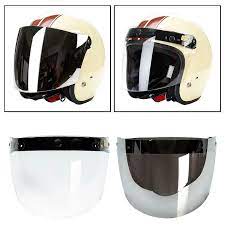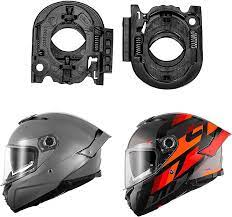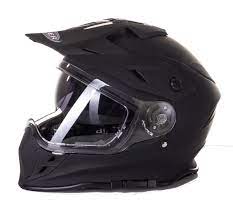Ultimate Guide to Motorcycle Helmet Visor Replacement: Ensure Clear Visibility and Safety on the Road

Motorcycle Helmet Visor Replacement Guide
Replacing the visor on your motorcycle helmet is an essential maintenance task that ensures clear visibility and protection while riding. Here’s a step-by-step guide to help you replace your helmet visor effectively:
Step 1: Gather Your Tools
Before starting the replacement process, make sure you have the necessary tools handy, such as a screwdriver (depending on your helmet model), a soft cloth for cleaning, and the new visor.
Step 2: Remove the Old Visor
Open your helmet fully to expose the visor mechanism. Locate the release mechanism or screws holding the visor in place. Carefully remove these components to detach the old visor from the helmet.
Step 3: Clean the Helmet Surface
Use a soft cloth and mild soapy water to clean the area where the visor attaches to the helmet. Ensure that it is free from dirt, dust, and debris before installing the new visor.
Step 4: Install the New Visor
Carefully align the new visor with the helmet’s mounting points. Follow the manufacturer’s instructions for securing it in place, whether it involves sliding it into position or tightening screws. Double-check that it is securely attached before closing your helmet.
Step 5: Test for Proper Functionality
After installing the new visor, test its functionality by opening and closing it several times to ensure smooth operation. Check for any obstructions or misalignments that may affect visibility while riding.
Step 6: Final Checks
Before hitting the road, perform a final inspection of your helmet to confirm that the visor is correctly installed and functioning optimally. Make any necessary adjustments if needed.
By following these steps, you can easily replace your motorcycle helmet visor and maintain clear visibility and protection during your rides. Remember to regularly inspect and clean your visor to ensure optimal performance and safety on the road.
Five Essential Tips for Safely Replacing Your Motorcycle Helmet Visor
- Ensure the helmet is clean before replacing the visor to prevent scratches.
- Follow the manufacturer’s instructions for removing and installing the visor correctly.
- Check for any damage on the visor or helmet that may affect its functionality.
- Avoid using harsh chemicals when cleaning the visor to prevent damage to its anti-fog coating.
- Test the new visor thoroughly before riding to ensure it provides clear vision and a secure fit.
Ensure the helmet is clean before replacing the visor to prevent scratches.
Before replacing the visor on your motorcycle helmet, it is crucial to ensure that the helmet is clean to prevent scratches. Dirt, dust, or debris on the helmet’s surface can cause abrasions when installing the new visor, potentially compromising its clarity and longevity. By taking the time to clean the helmet thoroughly before replacing the visor, you can maintain its pristine condition and ensure optimal visibility while riding. Remember, a clean helmet not only enhances safety but also prolongs the lifespan of your protective gear.
Follow the manufacturer’s instructions for removing and installing the visor correctly.
When replacing your motorcycle helmet visor, it is crucial to follow the manufacturer’s instructions for removing and installing the visor correctly. By adhering to the specific guidelines provided by the helmet manufacturer, you can ensure a seamless and proper replacement process. Following these instructions will help you avoid damaging the helmet or visor mechanism and guarantee that the new visor is securely attached, providing you with clear visibility and maximum protection while riding. Trusting in the manufacturer’s guidance is key to maintaining the integrity and functionality of your helmet visor.
Check for any damage on the visor or helmet that may affect its functionality.
When replacing your motorcycle helmet visor, it is crucial to check for any damage on the visor or helmet that could impact its functionality. Inspecting the visor for cracks, scratches, or discolouration ensures clear visibility while riding. Similarly, examining the helmet for any dents, loose parts, or structural issues is essential for maintaining safety and protection in case of an accident. By identifying and addressing any damage before replacing the visor, you can ensure that your helmet continues to provide optimal performance and safeguard you on your motorcycle journeys.
Avoid using harsh chemicals when cleaning the visor to prevent damage to its anti-fog coating.
It is important to avoid using harsh chemicals when cleaning your motorcycle helmet visor to prevent damage to its anti-fog coating. The anti-fog coating on the visor helps maintain clear visibility in various weather conditions, and using abrasive cleaners can strip away this protective layer, compromising its effectiveness. Instead, opt for mild soapy water and a soft cloth to gently clean the visor, ensuring that it remains in optimal condition for enhanced safety and visibility while riding.
Test the new visor thoroughly before riding to ensure it provides clear vision and a secure fit.
It is crucial to test the new motorcycle helmet visor thoroughly before heading out on a ride to guarantee both clear vision and a secure fit. By taking the time to ensure that the visor operates smoothly and without any obstructions, riders can enhance their safety on the road. Checking for proper alignment and functionality before riding can prevent visibility issues and discomfort during the journey, ultimately contributing to a more enjoyable and secure riding experience.




